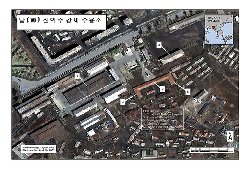It is estimated that 150,000-200,000 prisoners are detained in the camps, located in valleys in remote mountainous areas of the central and northern part of North Korea.
Deeply secretive North Korea does not publish any details of the camps or the detainees held in them, but accounts from former inmates and guards who have defected paint a bleak picture.
Other details have emerged from the study of satellite photographs by intelligence agencies and human-rights groups.
There are thought to be between six and eight main camps, with dozens of other smaller camps.
Conditions in the network of labor camps are reported to be extremely harsh, with rights groups saying that torture and ill-treatment are widespread and thousands of children held and forced to work as slave laborers alongside their parents.
Worked to death
Based on accounts from former detainees, human-rights groups believe the conditions are so harsh that at some camps 20-25 per cent of prisoners die every year.
According to a recently published report by the nongovernmental US Committee for Human Rights in North Korea, thousands of prisoners are forced to work - many to their deaths - in mining, logging, farming and industrial enterprises.
The committee's report entitled, The Hidden Gulag, said that the camps give out such meager food rations that prisoners are kept in a condition of "deliberately contrived semi-starvation".
Human-rights groups believe most of the prisoners in North Korean labor camps are political detainees, many serving life sentences and often with up to three generations of their family detained with them.
"Inmates are made to work from early morning till late at night in farms or factories, and minor infractions of rules can be met with severe beatings," Amnesty International's latest report on North Korea said.
Other camps are believed to hold North Koreans forcibly repatriated from China.
They are given similar treatment.
Experiments
Former inmates who have escaped North Korea have given accounts of brutal treatment inside the camps, including regular beatings, forced abortions, and rape.
Others have told of other experiments involving chemical and biological weapons resulting in the painful deaths of dozens of prisoners at a time.
At other times re-education classes involve long sessions where inmates are forced to memorize speeches by Kim Jong-il, the North Korean leader, word-for-word.
One of the most widely-published accounts of life in a North Korean labor camp is "The Aquariums of Pyongyang", written by former detainee Kang Chol-hwan.
'Vicious'
Aged just nine years old, Kang and his family were imprisoned in 1977 in the North's Yodok labor camp before being released a decade later.
Kang had been jailed because his grandfather had praised Japanese capitalism and was suspected of having "counter-revolutionary" sympathies.
During his time in the camp, Kang was witness to regular beatings and saw dozens of fellow inmates die either by execution or through workplace accidents, many involving children.
Kang, who now works as a journalist in South Korea, said the only lesson his experience in the camp had "pounded into me was about man's limitless capacity to be vicious".
PHOTO CAPTION
Satellite picture of labor camp (Gulag) in North Korea
Source: Aljazeera.net


 Home
Home Discover Islam
Discover Islam Quran Recitations
Quran Recitations Lectures
Lectures
 Fatwa
Fatwa Articles
Articles Fiqh
Fiqh E-Books
E-Books Boys & Girls
Boys & Girls  Articles
Articles










